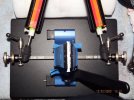This.^

There's no logic to the assumption that freehand is somehow less effective for burr removal, or sharpening in general, for that matter. I've no doubt that burr removal was perfected long before guided sharpeners ever existed, likely by centuries. It's about learned technique, awareness of what's going on with the edge and the persistent refinement of skills with the gear you choose to use.
Master the tools you have. Then, sharpening and the handling of burrs become easy.
Let's say you have a 15 dps edge that has a small burr. Freehand with just a tiny deviation, you hit the burr with at a 17 dps angle. Now you've created a microbevel on one side of your edge with a large burr. Or, let's say you hit it with a 13 dps angle. Now you've missed the burr altogether and just rounded the edge shoulders. Anyone who has read this subform for long knows that burr removal is a major problem for most people.
Freehand is another way to say "imprecise-hand." If you're good at freehanding and have a lot of experience, you can certainly get an excellent edge -- even a spectacular edge. But you have to be very good. A much less experienced sharpener can get a better edge with a good guided system.
In his classic book
The Razor Edge Book of Sharpening, John Juranitch found that only 1 in 20 butchers could properly sharpen a knife, which led to a great demand for his business and his writing the book. You say burr removal was "perfected" over centuries. Not by many. Not by 19 of 20 professionals who sharpened knives and used them for a living day in and day out.
Juranitch writes, "... there is no other field that is more ridden with old wives tales and gimmickry than the sharpening field." One of those old wives tales is using oil on oil stones. "... if you use oil in sharpening, it will: Number one -- cost you money. Number two -- make a mess. Number three -- give you an inferior edge."
How does Juranitch know that that it's bad to use oil on oil stones as people have done for ages? "We used electron microscopes with magnifications up to 10,000 power, and you could easily see the difference between the wet and dry edges. The edges that had been sharpened in oil had small chips knocked ou of the cutting edge; the dry-sharpened blades did not."
People like to divide into camps, thinking that one system is always better than the other. In reality, both freehand and guided systems have their place. Personally, I do both. But for my best edges, I aways use a WE guided system.
What people have done for a thousand years is no guarantee that today's technology isn't better. Sal made a fortune off a guided system. There's a reason for that success.



